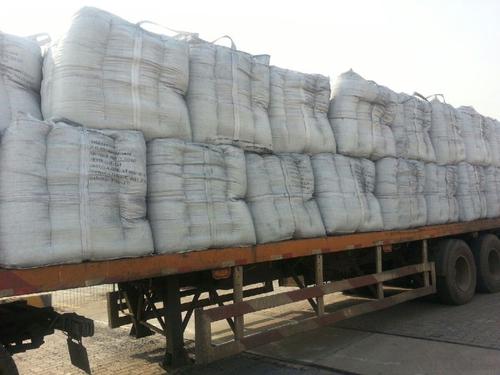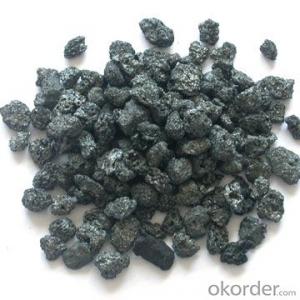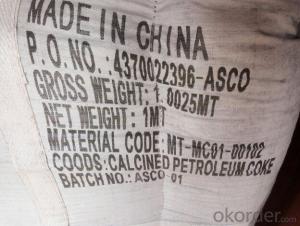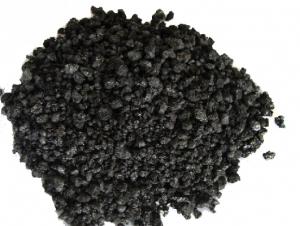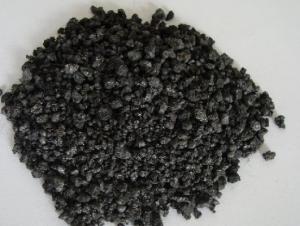Calcined Peroleum Coke with FC 98.5% S 0.55%
- Loading Port:
- Tianjin
- Payment Terms:
- TT OR LC
- Min Order Qty:
- 20 m.t.
- Supply Capability:
- 2000 m.t./month
OKorder Service Pledge
OKorder Financial Service
You Might Also Like
Packaging & Delivery
25kgs/50kgs/1ton per bag or as buyer's request
Calcined Petroleum Coke is a critical ingredient in the production of Metallurgy and chemical industrial ,it can increase the used quantity of Scrap steel and reduce the quantity of Scrap iron, or use no Scrap iron at all, the calcined petroleum coke has follow properties: high absorptive character, no residue will be left and save production cost.
Specifications
Calcined Anthracite
1.low sulphur, low ash
2.fixed carbon:95% -90%
3.sulphur:lower than 0.3%
4.Calcined Anthracite Coal
Advantage and competitive of caclined anthracite:
1. strong supply capability
2. fast transportation
3. lower and reasonable price for your reference
4.low sulphur, low ash
5.fixed carbon:95% -90%
6..sulphur:lower than 0.3%
General Specification of Calcined Anthracite:
| FC % | 98.5 | 98.5 | 98.5 | 99 |
| ASH % | 0.8 | 0.8 | 0.8 | 0.5 |
| V.M. % | 0.7 | 0.7 | 0.7 | 0.5 |
| S % | 0.5 | 0.55 | 0.7 | 0.5 |
| MOISTURE % | 0.5 | 0.5 | 0.5 | 0.5 |
Picture of CPC/ Calcined Petroleum Coke
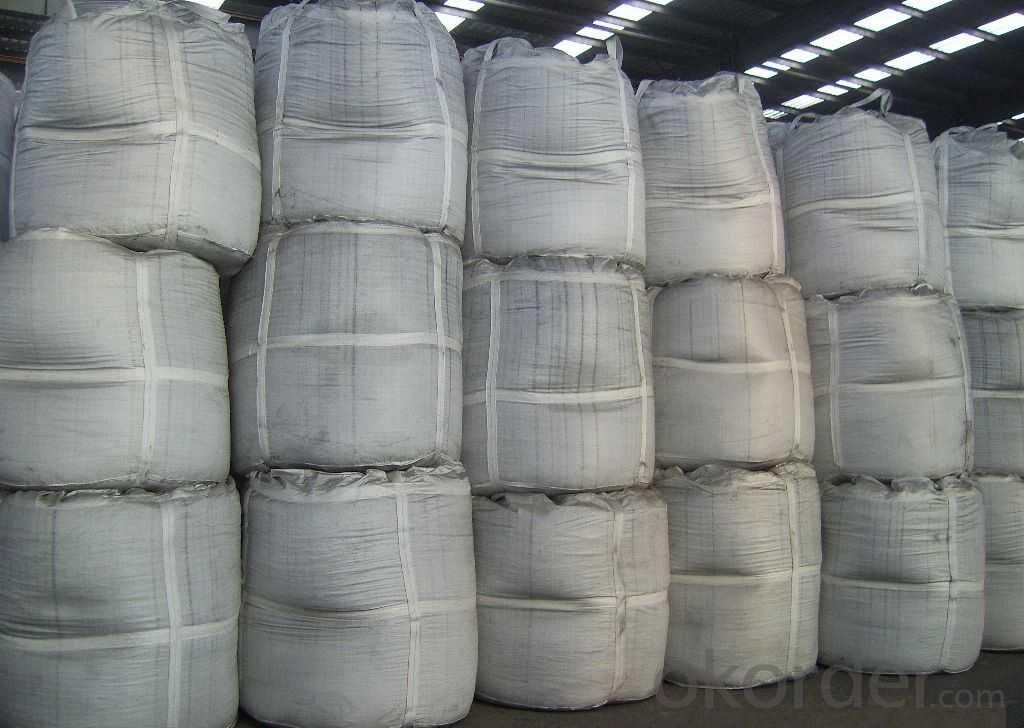
- Q: What is the role of carbonation in carbonated drinks?
- The role of carbonation in carbonated drinks is to provide the refreshing and effervescent sensation that is characteristic of these beverages. Carbonation is the process of dissolving carbon dioxide gas into a liquid, typically water, under pressure. This results in the formation of carbonic acid, which adds a tangy flavor to the drink. Carbonation serves several purposes in carbonated drinks. Firstly, it enhances the taste by adding a unique bubbly sensation that stimulates the taste buds and gives a refreshing mouthfeel. The effervescence created by the carbonation also contributes to the overall sensory experience of the drink, making it more enjoyable to consume. Furthermore, carbonation acts as a natural preservative in carbonated drinks. The carbon dioxide gas inhibits the growth of bacteria and other microorganisms, thereby extending the shelf life of the beverage. This is particularly important for soft drinks that are often stored for extended periods before consumption. In addition to taste and preservation, carbonation plays a role in the presentation of carbonated drinks. The release of carbon dioxide gas from the liquid creates bubbles and fizz, making the drink visually appealing and enticing. This visual appeal is often associated with a feeling of luxury and indulgence. Overall, carbonation is an essential component of carbonated drinks, providing taste, preservation, and visual appeal. It enhances the sensory experience and contributes to the overall enjoyment of these beverages.
- Q: What are the different types of carbon fibers?
- Different carbon fibers have distinct characteristics and properties. Some widely used types are as follows: 1. Carbon fibers based on polyacrylonitrile (PAN): These are the most commonly utilized carbon fibers and are derived from PAN precursor materials. They provide a balanced combination of strength, stiffness, and cost-efficiency. 2. Carbon fibers based on coal tar pitch or petroleum pitch: These fibers are made from precursor materials like coal tar pitch or petroleum pitch. They typically possess higher density and thermal conductivity compared to PAN-based fibers, making them suitable for applications that require excellent thermal stability. 3. Carbon fibers based on regenerated cellulose (rayon): These fibers are produced from regenerated cellulose, commonly known as rayon. They have lower modulus and strength compared to PAN-based fibers but offer exceptional electrical conductivity. Consequently, they find extensive use in applications such as conductive textiles and electrical components. 4. Carbon fibers based on mesophase pitch: These fibers are manufactured from a precursor material called mesophase pitch, which is a liquid crystalline substance. They possess high modulus and excellent thermal conductivity, making them ideal for applications that demand high strength and heat resistance, like the aerospace and automotive industries. 5. Vapor-grown carbon fibers (VGCFs): These fibers are created through the chemical vapor deposition (CVD) method. They have a unique tubular structure and high aspect ratio, resulting in exceptional mechanical and electrical properties. VGCFs are often employed in advanced composite materials and nanotechnology applications. It is crucial to consider the specific requirements of the application, such as mechanical strength, thermal stability, electrical conductivity, or cost-effectiveness, when selecting the appropriate carbon fiber type.
- Q: What are the impacts of carbon emissions on urban environments?
- Carbon emissions have significant impacts on urban environments. Firstly, they contribute to the greenhouse effect, leading to climate change and increased temperatures in cities. This can result in heatwaves, reduced air quality, and worsened health conditions for urban dwellers. Secondly, carbon emissions from transportation and industries contribute to air pollution, leading to respiratory problems and other health issues. Additionally, carbon emissions are a major driver of global warming and sea-level rise, posing a threat to coastal cities. To mitigate these impacts, cities need to prioritize sustainable transportation, energy-efficient buildings, and renewable energy sources to reduce carbon emissions and create healthier urban environments.
- Q: What is the chemical symbol for carbon?
- The chemical symbol for carbon is C.
- Q: What's the difference between an alkaline cell and a carbon cell?
- Alkaline batteries, also known as alkaline dry cells, alkaline manganese dioxide batteries and alkaline manganese batteries, are among the best in the range of zinc manganese batteries. The utility model is suitable for large discharge capacity and long time use. The internal resistance of the battery is low, so the current produced is larger than that of the general manganese battery, while the environmental friendly mercury content is only 0.025%. A carbon cell belongs to a primary battery in a chemical power supply and is a disposable battery. Because the chemical power unit has an electrolyte that is a non flowing paste, it is also called a dry cell, as opposed to a battery with a flowing electrolyte. Carbon battery is not only suitable for the flashlight, radios, tape recorders, cameras, semiconductor, electronic clocks, toys and other fields, but also for national defense, scientific research, telecommunication, navigation, aviation, medicine, etc. in the national economy.
- Q: What are the properties of carbon-based adhesives?
- Carbon-based adhesives have several properties that make them versatile and widely used in various industries. Firstly, carbon-based adhesives are known for their excellent bonding strength. They have the ability to create strong and durable bonds between different materials, including metals, plastics, ceramics, and composites. This makes them suitable for applications where a reliable and long-lasting bond is required. Another important property of carbon-based adhesives is their high temperature resistance. They can withstand extreme temperatures without losing their adhesive properties, making them ideal for applications in high-temperature environments. This property also allows carbon-based adhesives to be used in industries such as aerospace and automotive, where components are subjected to elevated temperatures. Carbon-based adhesives also possess good chemical resistance, meaning they can withstand exposure to various chemicals without degradation. This property makes them suitable for use in industries where adhesives may come into contact with solvents, fuels, or harsh chemicals. Additionally, carbon-based adhesives exhibit excellent electrical conductivity. This property allows them to be used in applications where electrical or thermal conductivity is required, such as in the electronics industry. Furthermore, carbon-based adhesives often have low shrinkage and low outgassing characteristics. This means that they do not significantly change in size or release volatile substances during curing, minimizing the risk of damage or contamination to surrounding materials. Overall, carbon-based adhesives offer a combination of high bonding strength, temperature resistance, chemical resistance, electrical conductivity, and dimensional stability, making them a preferred choice in various industries where reliable and durable bonding solutions are needed.
- Q: Which carbon content is larger, steel or pig iron?
- Iron and steel is distinguished by carbon: carbon content below 2.11% for carbon steel, according to can be divided into carbon steel low carbon steel (WC = 0.25%), carbon steel (WC0.25% - 0.6%) and high carbon steel (WC>0.6%);
- Q: The victory of the lightning 3361 material is full of carbon fiber, and the 3363 is made of carbon fiber and resin, which is better??
- All carbon fiber is good. The resin is only used for the badminton line, not for the racket.All carbon fiber material, is the most important material for badminton racket, all carbon fiber, good toughness, but also take into account the light performance.Carbon composite fiber, that is, in the carbon fiber added ordinary metal elements, such as aluminum, this material is relatively heavy, and toughness is not all carbon material.The best one is the carbon fiber material of racket frame which added to the rare metal, adding rare metal frame strong resilience, stability is better, and more suitable for double play.
- Q: Learn photography for nearly half a year, has always wanted to buy a tripod, want to buy carbon fiber tripod, what brand is better? The machine is D700+24-70About 3000 is too expensive ~ consider 1000 more just fine. Wage earners!
- Three tripod according to the budget to choose the brand, Nikon D700 SLR camera lens with the weight of 24-70 does not have what problem, maximum diameter of 28mm on the line.If the budget is around 7000 only buy JX, may also consider the budget nearly manfrotto.If the budget is below 3000, recommended to choose the source or berno.Budget 1000 yuan level, do not have to consider carbon fiber, and this carbon fiber three tripod does not necessarily fly.
- Q: What are the different types of carbon-based composites?
- There are several different types of carbon-based composites, including carbon fiber reinforced polymers (CFRP), carbon nanotube composites, carbon nanofiber composites, and graphene composites.
Send your message to us
Calcined Peroleum Coke with FC 98.5% S 0.55%
- Loading Port:
- Tianjin
- Payment Terms:
- TT OR LC
- Min Order Qty:
- 20 m.t.
- Supply Capability:
- 2000 m.t./month
OKorder Service Pledge
OKorder Financial Service
Similar products
Hot products
Hot Searches


